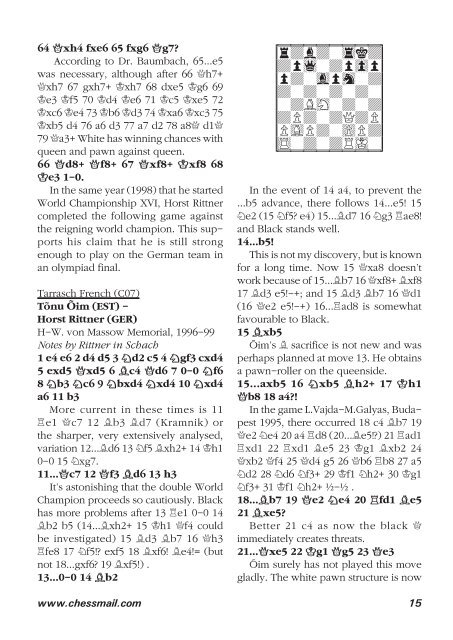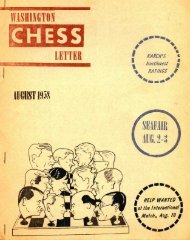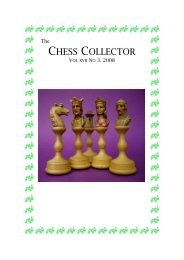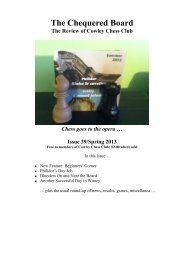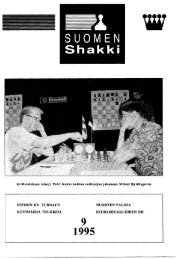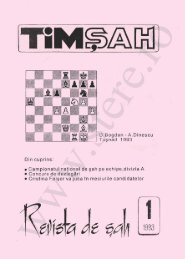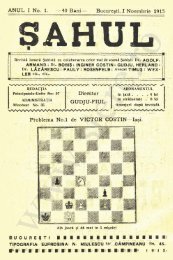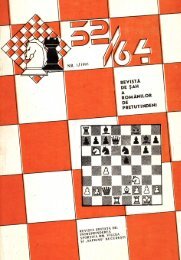Chess Mail
El ajedrez es un juego, considerado un deporte, entre dos personas, cada una de las cuales dispone de 16 piezas móviles que se colocan sobre un tablero dividido en 64 escaques. En su versión de competición está considerado como un deporte.
El ajedrez es un juego, considerado un deporte, entre dos personas, cada una de las cuales dispone de 16 piezas móviles que se colocan sobre un tablero dividido en 64 escaques. En su versión de competición está considerado como un deporte.
Create successful ePaper yourself
Turn your PDF publications into a flip-book with our unique Google optimized e-Paper software.
64 £xh4 fxe6 65 fxg6 £g7?<br />
According to Dr. Baumbach, 65...e5<br />
was necessary, although after 66 £h7+<br />
£xh7 67 gxh7+ ¢xh7 68 dxe5 ¢g6 69<br />
¢e3 ¢f5 70 ¢d4 ¢e6 71 ¢c5 ¢xe5 72<br />
¢xc6 ¢e4 73 ¢b6 ¢d3 74 ¢xa6 ¢xc3 75<br />
¢xb5 d4 76 a6 d3 77 a7 d2 78 a8£ d1£<br />
79 £a3+ White has winning chances with<br />
queen and pawn against queen.<br />
66 £d8+ £f8+ 67 £xf8+ ¢xf8 68<br />
¢e3 1–0.<br />
In the same year (1998) that he started<br />
World Championship XVI, Horst Rittner<br />
completed the following game against<br />
the reigning world champion. This supports<br />
his claim that he is still strong<br />
enough to play on the German team in<br />
an olympiad final.<br />
Tarrasch French (C07)<br />
Tõnu Õim (EST) -<br />
Horst Rittner (GER)<br />
H-W. von Massow Memorial, 1996-99<br />
Notes by Rittner in Schach<br />
1 e4 e6 2 d4 d5 3 ¤d2 c5 4 ¤gf3 cxd4<br />
5 exd5 £xd5 6 ¥c4 £d6 7 0–0 ¤f6<br />
8 ¤b3 ¤c6 9 ¤bxd4 ¤xd4 10 ¤xd4<br />
a6 11 b3<br />
More current in these times is 11<br />
¦e1 £c7 12 ¥b3 ¥d7 (Kramnik) or<br />
the sharper, very extensively analysed,<br />
variation 12...¥d6 13 ¤f5 ¥xh2+ 14 ¢h1<br />
0–0 15 ¤xg7.<br />
11...£c7 12 £f3 ¥d6 13 h3<br />
It’s astonishing that the double World<br />
Champion proceeds so cautiously. Black<br />
has more problems after 13 ¦e1 0–0 14<br />
¥b2 b5 (14...¥xh2+ 15 ¢h1 £f4 could<br />
be investigated) 15 ¥d3 ¥b7 16 £h3<br />
¦fe8 17 ¤f5!? exf5 18 ¥xf6! ¥e4!= (but<br />
not 18...gxf6? 19 ¥xf5!) .<br />
13...0–0 14 ¥b2<br />
www.chessmail.com<br />
XIIIIIIIIY<br />
9r+l+-trk+0<br />
9+pwq-+pzpp0<br />
9p+-vlpsn-+0<br />
9+-+-+-+-0<br />
9-+LsN-+-+0<br />
9+P+-+Q+P0<br />
9PvLP+-zPP+0<br />
9tR-+-+RmK-0<br />
xiiiiiiiiy<br />
In the event of 14 a4, to prevent the<br />
...b5 advance, there follows 14...e5! 15<br />
¤e2 (15 ¤f5? e4) 15...¥d7 16 ¤g3 ¦ae8!<br />
and Black stands well.<br />
14...b5!<br />
This is not my discovery, but is known<br />
for a long time. Now 15 £xa8 doesn’t<br />
work because of 15...¥b7 16 £xf8+ ¥xf8<br />
17 ¥d3 e5!–+; and 15 ¥d3 ¥b7 16 £d1<br />
(16 £e2 e5!–+) 16...¦ad8 is somewhat<br />
favourable to Black.<br />
15 ¥xb5<br />
Õim’s ¥ sacrifice is not new and was<br />
perhaps planned at move 13. He obtains<br />
a pawn-roller on the queenside.<br />
15...axb5 16 ¤xb5 ¥h2+ 17 ¢h1<br />
£b8 18 a4?!<br />
In the game L.Vajda-M.Galyas, Budapest<br />
1995, there occurred 18 c4 ¥b7 19<br />
£e2 ¤e4 20 a4 ¦d8 (20...¥e5!?) 21 ¦ad1<br />
¦xd1 22 ¦xd1 ¥e5 23 ¢g1 ¥xb2 24<br />
£xb2 £f4 25 £d4 g5 26 £b6 ¦b8 27 a5<br />
¤d2 28 ¤d6 ¤f3+ 29 ¢f1 ¤h2+ 30 ¢g1<br />
¤f3+ 31 ¢f1 ¤h2+ ½–½ .<br />
18...¥b7 19 £e2 ¤e4 20 ¦fd1 ¥e5<br />
21 ¥xe5?<br />
Better 21 c4 as now the black £<br />
immediately creates threats.<br />
21...£xe5 22 ¢g1 £g5 23 £e3<br />
Õim surely has not played this move<br />
gladly. The white pawn structure is now<br />
15


